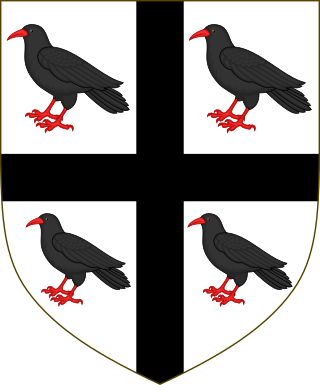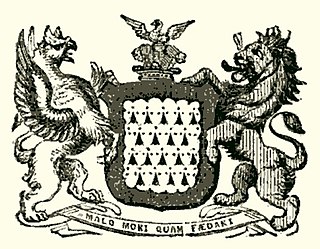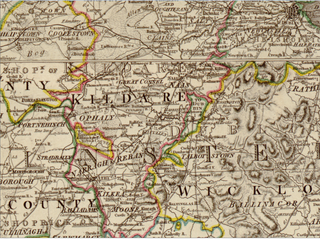Related Research Articles
Baron Louth is a title in the Peerage of Ireland. It has been created twice.

Lord Aylmer, Baron of Balrath, in the County of Meath, is a title in the Peerage of Ireland. It was created in 1718 for the naval commander Matthew Aylmer, the second son of Sir Christopher Aylmer, 1st Baronet, of Balrath. Lord Aylmer's son, the second Baron, represented Rye in the House of Commons. The latter's grandson, the fourth Baron, succeeded his kinsman as seventh Baronet, of Balrath, in 1776. The titles remain united. He was succeeded in both titles by his son, the fifth Baron. He was a general in the Army and served as Governor General of Canada from 1830 to 1835. Lord Aylmer assumed by Royal licence the additional surname of Whitworth in 1825 on the death of his uncle Charles Whitworth, 1st Earl Whitworth. On his death, the titles passed to his younger brother, the sixth Baron. He was an admiral in the Royal Navy.

The title Baron of Dunsany or, more commonly, Lord Dunsany, is one of the oldest dignities in the Peerage of Ireland, one of just a handful of 13th- to 15th-century titles still extant, having had 21 holders, of the Plunkett name, to date. Other surviving medieval baronies include Kerry, Kingsale, Trimlestown (1469), Baron Louth, and Dunboyne.

Admiral of the Fleet Matthew Aylmer, 1st Baron Aylmer, of Covent Garden, Westminster, and Westcliffe, near Dover, was an Anglo-Irish Royal Navy officer and Whig politician who sat in the English and British House of Commons between 1695 and 1720.
Plunkett is an Irish surname derived from the Gaelic Ó Pluingceid. It is associated with Ireland, and possibly of Norse or Norman origin; it may be spelled O'Plunket, Plunket, Plunkit, Plunkitt, Plonkit, Plonkitt, Plonket, Plonkett, or Ó Plunceid, and may refer to:

There have been two baronetcies created for persons with the surname Aylmer, both in the Baronetage of Ireland. Both titles are extant.
John William Plunkett, 17th Baron of Dunsany was an Anglo-Irish Conservative politician and peer.
Christopher Plunkett, 1st Baron of Dunsany was an Anglo-Norman peer. He was the second son of Christopher Plunkett, 1st Baron Killeen.
Sir Gerald Aylmer was an Irish judge in the time of Henry VIII, who played a key part in enforcing the Dissolution of the Monasteries. His numerous descendants included the Barons Aylmer.
General Sir William Stewart, was a Scottish-born soldier, Commander-in-chief of Queen Anne's Forces in Ireland, Member of Parliament for County Waterford and a Privy Councillor. He was a benefactor of Hanover Square, London, donating the land and laying the first stone of St George's, Hanover Square.
Sir Valentine Browne, 1st Viscount Kenmare and 3rd Baronet Browne of Molahiffe (1638–1694), was an Irish Jacobite who fought for James II of England in the Williamite War in Ireland.

John Barnewall, 3rd Baron Trimleston, was an Irish nobleman, judge and politician. He was the eldest son of Christopher Barnewall, 2nd Baron Trimlestown and his wife Elizabeth Plunket, daughter of Sir Thomas Fitz-Christopher Plunket of Rathmore, Lord Chief Justice of the King's Bench in Ireland and his second wife Marian Cruise. He succeeded his father as 3rd Baron in about 1513. His father, like most of the Anglo-Irish aristocracy, had supported the claim of the pretender Lambert Simnel to the English throne in 1487. After the failure of Simnel's rebellion, he received a royal pardon.

The High Sheriff of Kildare was the British Crown's judicial representative in County Kildare, Ireland from the 16th century until 1922, when the office was abolished in the new Free State and replaced by the office of Kildare County Sheriff. The High Sheriff had judicial, electoral, ceremonial and administrative functions and executed High Court Writs. In 1908, an Order in Council made the Lord Lieutenant the Sovereign's prime representative in a county and reduced the High Sheriff's precedence. However, the sheriff retained his responsibilities for the preservation of law and order in the county. The usual procedure for appointing the sheriff from 1660 onwards was that three persons were nominated at the beginning of each year from the county and the Lord Lieutenant then appointed his choice as High Sheriff for the remainder of the year. Often the other nominees were appointed as under-sheriffs. Sometimes a sheriff did not serve his full term due to death or another event, and another sheriff was then appointed for the remainder of the year. The dates given in this article are the dates of appointment.
Sir William Welles was an English-born statesman and judge in fifteenth-century Ireland, who held the office of Lord Chancellor of Ireland. He was the younger brother of Lionel de Welles, 6th Baron Welles. Lionel was a prominent supporter of the House of Lancaster, who was killed at the Battle of Towton on 29 March 1461.
Robert Plunkett, 5th Baron Dunsany was an Anglo-Irish nobleman of the Tudor period.
Nicolas Lawless, 1st Baron Cloncurry, known as Sir Nicholas Lawless, Bt, between 1776 and 1789, was an Irish peer, wool merchant, banker and politician.
Sir John Barnewall (c.1635-c.1705) was an Irish landowner, barrister and judge, who held several judicial offices, including that of Recorder of Dublin 1687-9.
George Aylmer was an Irish officer of the Royal Navy during the seventeenth century.
Baron Galtrim was an Irish feudal barony: in other words, the holder of the barony, which was hereditary in the Hussey family, was entitled to style himself Lord Galtrim, but was not entitled as of right to sit in the Irish House of Lords, although at least two holders of the title did receive a summons to sit in Parliament, and a third sat in the House of Commons. The title was created in the late fourteenth century by summons to Parliament. Use of the title lapsed in the early nineteenth century: from then on the former Lord Galtrim was usually referred to simply as "Mr. Hussey of Rathkenny".
Luke Plunket, 3rd Earl of Fingall (1639–1684) was an Irish soldier and politician. He was one of the signatories of the Catholic Remonstrance of 1661.
References
- ↑ Stewart p.13